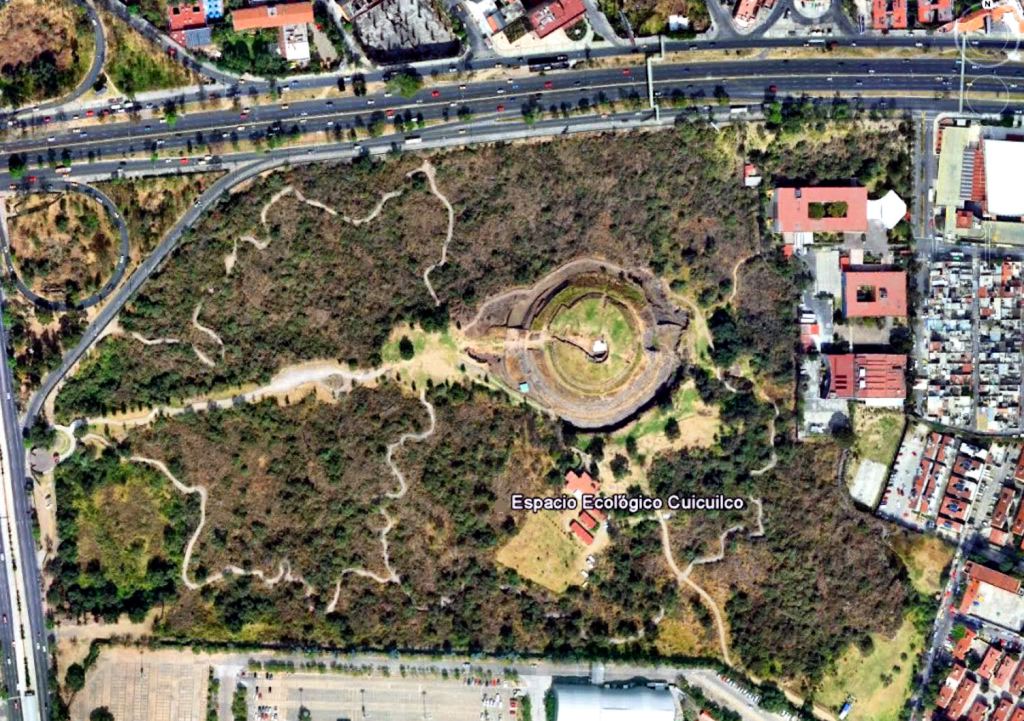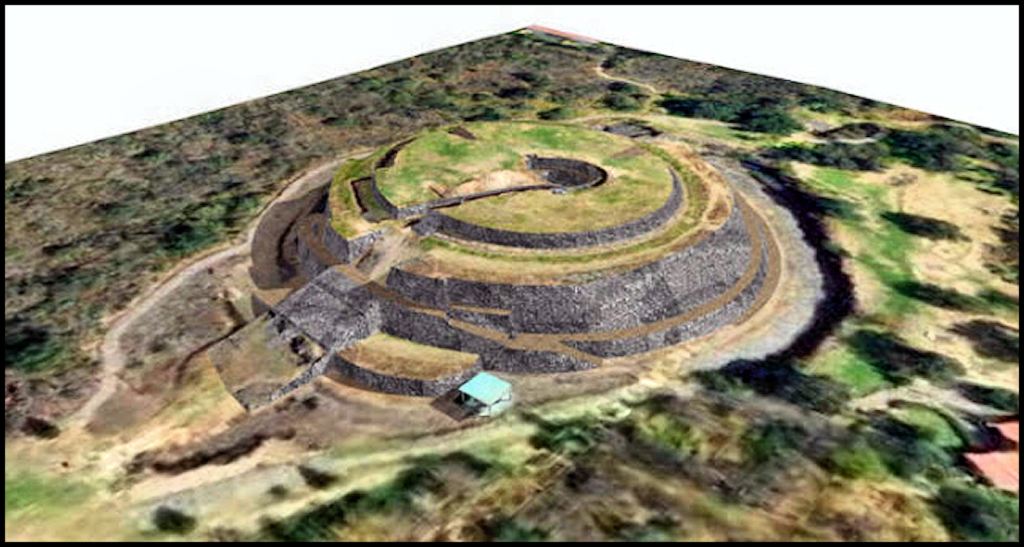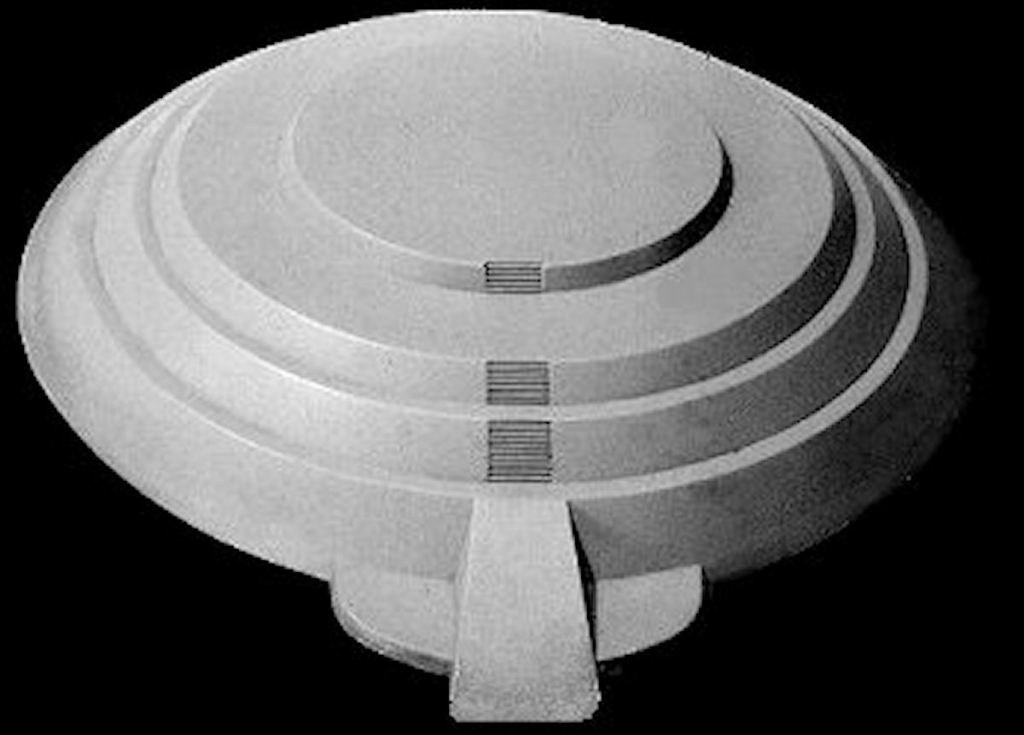by Richard L. Thornton, Architect and City Planner
One Summer in Mexico – Part Sixteen – July 19, 1970
Basílica de Nuestra Señora de Guadalupe y
Cuicuilco – Estado de México
From my journal
Although Alicia’s mother is actually Sephardic Jewish in ethnicity and typically only goes to mass maybe twice a year, she called me a “diablo protestante” the other night after consuming too many cocktails at a restaurant in Colonia San Angel. Alicia’s whole family makes a point of saying that they speak “Christiano” – never use the word Spanish. Actually, the Soto’s also often say they speak “Christiano.”
Hoping to patch things up by showing her family that I was a Christian also, Alicia suggested that we all attend mass today at Mexico’s holiest shrine, Basílica de Nuestra Señora de Guadalupe. So, Sunday morning her mother, her cousin Carmanita, Alicia and I went to church together. Her mother was shocked, when I was not struck by lightning on the plaza in front of the church. Estella was shocked again, when I knew a whole lot more Latin than she did during the service. I was shocked to see the entire altar, covered in gold, when there is so much poverty in Mexico. Not a single person in the basilica even smiled at us, much less shake hands or speak.

Throughout the distance from the outer gate to the main doors (courtyard) we had to fight through beggars, candy vendors, nuns selling magazines, teenage girls selling rosaries and crucifixes, monks selling prayer cards, toy vendors and even money changers to convert foreign currencies into pesos. I wanted to scream abomination! but fortunately kept my mouth shut.
Alicia and I have a secret. She was curious to what Protestant churches were like. Sunday two weeks ago, when we told her mother that we were going to mass with the Soto’s (who never go to mass) we attended Iglesia Metodista Bethel. (Bethel Methodist Church). Now I was shocked. There were Methodist churches all over Mexico City and they were thriving. Some are all Korean or all African churches, but the majority of Methodists there are Mexican citizens, who had changed denominations, while attending college in the United States. Their service was much more informal than Methodist churches in the United States. I really liked the format of lots of music with people standing up to say what was ever on their mind – and a short sermon. Alicia was squeezing my hands and thighs the whole time. We took communion together up at the altar and she was not struck by lightning!

- Later in the summer, I took communion at Catholic mass with Alicia, when her family was not around. I wasn’t struck by lightning either . . . well, not until July 5, 2019!
Alicia was completely stunned, when at the end of the service, dozens of people came up to us to speak. They all thought that we were either married or living together. Alicia was delighted to play the part of making them think that we lived together by wrapping her arm around mine tightly. They invited us to go to Sunday dinner with them, but I told them that I had to be back at the Soto house for a family dinner and was going to be at Teotihuacan all week. We’re going to meet Alfredo and Susana Barragon at Sanborn’s next week. He’s a civil engineer and went to Texas A & M. Her nursing degree is from the University of Houston, a Methodist school. Alfredo became a Methodist while dating Susana in Texas.
Alicia is obsessed with getting on the pill. She was all excited when I told her that Protestant ministers never even discussed birth control pills and almost all Catholic women in the US also are on the pill, if they are not ready for children. Never, ever in my life have had a girlfriend who constantly talks about wanting to have sex with me as soon as it is safe. This is wild. We have only known each other 3 weeks!
The Divorce Thang
Please step into my time machine as we jump forward to the afternoon of July 22, 1970 at Sanborns with Alfredo and Susana Barrigon. They said that the “United States college students” explanation of the growth of Methodist churches in Mexico City was partially true, but most of their growth had been because many of the churches were functioning as dating and matchmaking services for divorced women.
In 1970, a divorced middle class or upper-class woman in Mexico was branded as “damaged goods.” The situation has not dramatically changed by these times. She had the options of being a miserable, dead-souled spinster like Alicia’s mother, a mistress for some married man or a nun. If a man had enough money, he had no problem buying an annulment from the Catholic church and then finding himself a young gold-digger. However, almost all of them had mistresses before divorcing so it was not like they were suffering deprivation.
Men from North America and northern Europe with Protestant backgrounds knew that they could join a Methodist church in Mexico and quickly have their choice of divorcees for a wife (but not a mistress) . . . many of whom would have been considered beauty queens in other countries. The Methodist Church’s opposition to legalized prostitution and polygamy was quite evident in sermon by the minister at Bethel Methodist.
The Roman Catholic Church in Mexico at that time openly tolerated prostitution and polygamy as a means of Upper/Middle-Class birth control. After having her second, third or fourth child, a “high-born” wife could expect to live the rest of her life in celibacy, as her husband took on more and more young mistresses. Only the legitimate offspring could expect to share in the accumulated wealth of their father after his death. In a mega-city like Mexico City, divorcees could attend Protestant churches anonymously since there was practically no social interaction among communicants at Catholic churches.
I finally figured out that the reason that Lupe Soto almost immediately encouraged me to visit prostitutes was that she was trying to protect her daughters. After all, only an interior wall separated their bedroom from mine. I really didn’t have that much in common with the daughters intellectually and was afraid of catching some disease from prostitutes. Thus, the Sotos were quite cooperative in my passionate romance with Alicia, which would have seemed normal in the US at that time, but was rather risqué in a Mexico undergoing social transition. Alicia would tell her mother that she was at the Soto’s, when we were really somewhere else with privacy. The Sotos knew to cover for me, if her mother checked on her. Keep in mind that Alicia was almost 20 – not a young teenybopper.
I never got to see Alfredo and Susana again because for the rest of my time in Mexico, I would be gone to remote parts of the republic or even Central America during the week days. Otherwise, we would have become good friends.


Cuicuilco
The Cuicuico Archaeological Zone is in the southwest portion of Metro Mexico City and in the Pedregal on the former shores of Lake Texcoco. We grabbed a picnic dinner for two at a Kentucky Fried Chicken near the university before heading on to Cuicuilco. My journal said that I was not impressed when we first drove up to the round pyramid. It was much shorter than Mound A at Etowah Mounds in Georgia. In fact, up to that time none of the pyramids were as big as the one at Etowah except the two monsters at Teotihuacan.

Cuicuilco was founded as an agricultural village around 1400-1200 BC. According to the INAH, the word means, “Place where songs and dances are made,” but that name was given long after its inhabitants were gone. During the period 1000–800 BC, conical structures with oval bases were built. It was a major regional center, essentially a city, from around 700 BC to 170 AD. Cuicuilco was destroyed by the Xitle Volcano around 170 AD and covered with volcanic ash and lava by the same volcano around 400 AD.
Cuicuilco may be the oldest city in the Valley of Mexico and was roughly contemporaneous with the Mother Culture, falsely called the Olmec Civilization in southern Mexico. It was a major competitor with Teotihuacan until around 100 BC. After then most of the population growth of the region occurred in and near Teotihuacan.

The plan of the city was focused on a circular mound on the top of the highest hill. Major public buildings were round and built on smaller conical mounds, veneered with volcanic stone. Water was brought to the city with an aqueduct and then distributed in stone cisterns, branching out from the center of the city.
The unusual circular architecture of Cuicuilco disappeared from the Valley of Mexico after the destruction of Cuicuilco. The tradition continued on a lake near Tequila, Jalisco for many more centuries, then moved to western Tamaulipas State and ultimately the Lower Mississippi River Basin. It is quite possible that the Tunica and Chitimacha Tribes in Louisiana are descended or partially descended from the conical mound builders in Central Mexico, during earlier times.

Cuicuilco’s importance is recognized by most historians and archaeologists. Unfortunately, it has barely been studied, especially when compared with other archaeological sites, such as Teotihuacan and Tula. The main investigation obstacle is that the area is covered almost entirely with a lava layer of about 9 to 10 meters thick. This difficulty is compounded by urbanization of the area, with constructions directly above the archaeological site, such as the Olympic Sports Complex, Telmex building and the Cuicuilco commercial Plaza in 1997.
The four ducklings

Only a few minutes after Alicia and I began measuring the central pyramid at Cuicuilco, we noticed four kids following us like ducklings, but always keeping about 20 feet separation from us. When we stopped, they stopped. When we walked, they walked. This went on for about 30 minutes. Finally, Alicia became curious and walked back to ask them if they needed anything. I heard their astonishing response.
¡Eres Santa María bonita y San Juan fuerte! (Y’all are beautiful Mary and strong Saint John.)
Alicia explained that she was definitely not Mary the Mother of Jesus and I was not the disciple John. She then explained to me that the children thought we were saints, but they looked very unkempt and hungry. The niños heard a strange language, which then convinced them of our heavenly origin: ”¡El señor y la senora son ángeles!” (The lord and lady are angels.)
Alicia explained them to again that we were regular humans. The niños held a brief conference then their leader asked us, ¿Serás nuestra madre y padre? (Will y’all be our mother and father?) I understood that!
Alicia blushed and explained that we were not married. The niños still didn’t understand because in their level of society, most men and women just shacked up. They couldn’t afford a marriage license or a priest for a church wedding. Then she tried to explain that I lived far away in a very different place. The only way to get there was to fly in the sky. She pointed up into the sky.
The four niños then shouted “OVNI, ¡eres un ovnis!” (UFO, you are UFO’s.) I pulled my camera out of the camera bag, assuming that they would finally realize that I was a tourist (of sorts). Oh no! They shouted, “¡Pistola de rayos! (ray gun!) The little girl and the littlest boy began crying in terror.
Alicia walked over to a vendor and bought some cheap candy then handed it to them. She explained what a camera was. No one had ever taken a photo of them, but they knew what a photo was. The boy stopped crying, but the little girl remained terrified of me. I took the photo.
Most Middle Class and Upper-Class Mexicans at that time treated Native American servants like little more than slaves. Most Upper Middle-Class Mexican college coeds like Alicia would have long since told the niños to get the hell out of our way. Not Alicia. She asked the leader, if they had eaten anything that day. They had not! She invited them to follow her to the vendors stalls. She bought each of them a full dinner then told them that their family was calling for them. They didn’t have parents, but apparently someone was giving them shelter at night, but little food. She waited until they had walked to the edge of the park then returned to me.
That was the exact moment that I fell totally in love with Alicia. It’s one thing to be highly intelligent, a free thinker and sexy. It is another thing to be compassionate with the downtrodden, when society expects you to behave otherwise. Indeed, she was an angel.
The truth is that I received more sincere emotional and physical nurturing during an evening of watching TV on her living room couch, than I did in my whole marriage and certainly in all the dates that I have had since then. All the Gringas, who I have met since being single again, viewed the relationship of a man and woman as a business venture in which dating was a smorgasbord for maximizing one’s future economic status. They were emotionally incapable of either giving or receiving love 100%. T’is better to have known true love and lost it . . . than to have never known it at all.

Alicia is a very attractive woman. The eye sees and the mind and body wants. Do you think you will ever see her again? I just turned 68 and only the desire remains, hopefully I will find somebody some day that I can watch football on TV with, and discuss current events. Stay safe Richard.
LikeLike
I don’t know if she is even alive. The last time that I saw any evidence of her existence was in early 2009, when a home that she owned in Cancun, was foreclosed on. Having lived in large, polluted cities like Mexico City and Naples, Italy – while I was on a mountain farm or home most of my adult life, would have radically differentiated our health and aging rate. My g-grandfather was 78 and my g-grandmother was 28, when my grandmother was born. She had two younger sisters. Apparently, Eastern Creeks have hybrid vigor. LOL
LikeLiked by 1 person
Howdy, Interesting…just yesterday was reading about Coba and round pyramid there.
On Wed, Jul 29, 2020 at 7:43 PM The Americas Revealed wrote:
> alekmountain posted: ” by Richard L. Thornton, Architect and City Planner > One Summer in Mexico – Part Sixteen – July 19, 1970 Basílica de Nuestra > Señora de Guadalupe y Cuicuilco – Estado de México From my journal Although > Alicia’s mother is actually Sephardic ” >
LikeLiked by 1 person
I didn’t get to go to Coba. There was a Marxist guerilla army between the nearest safe town with a bus stop in Guatemala and the nearest safe bus stop that would take one to Coba, Honduras. At the time, there were four guerilla armies operating in Guatemala, plus the Guardia (army) which had a reputation for killing strangers from other countries. One of my assignments was to make contact with a new insurgent group which was receiving arms and munitions, stolen from the US Army near Washington, DC – plus weapons from the Irish Republican Army.
LikeLiked by 1 person
I just received a direct email from a reader with a questions. The divorced women moved to Methodist churches because they were not allowed to remarry in a Catholic church and most Mexican men would not consider marrying them anyway. 2) Wouldn’t the divorced women be excommunicated for attending a Methodist church? No – the Roman Catholic priests had no clue, who attended their Masses and there were hundreds of people each week going to confession – which was a big money maker for the church. On the other hand, the Methodist Church accepts baptism from any other Christian denomination. So, all these women had to do was to join the local Methodist church. There was no requirement that they also formerly leave the Roman Catholic Church. When they remarried a Protestant husband in a Methodist church, it was highly unlikely that the Roman Catholic bureaucracy would ever find out since Mexico City had such a huge population. Now the RC church would consider these women to be living in sin . . . while looking the other way when “good Catholic women” became mistresses. The bad situation for women in Mexico was what made Alicia such a rebel. She was not a Marxist, or anything similar, she was just a smart young lady who was tired of women being treated like chattel in Latin American countries.
LikeLiked by 1 person
Richard, kind of looks like ancient people were seeing “UFO’s” with some of these mounds. I wasn’t a big UFO believer until the Pentagon types started talking. They must know something is about to happen.
LikeLike
I noticed that too! We have already been told that there were numerous UFO wrecks in the possession of the Pentagon after 75 years of being told that no wrecks exist.
LikeLike